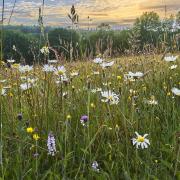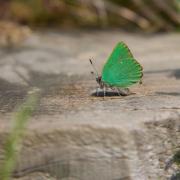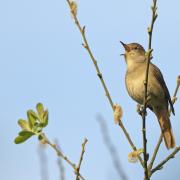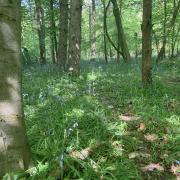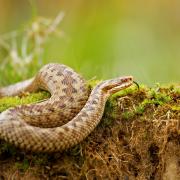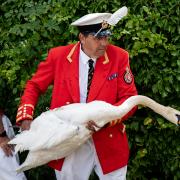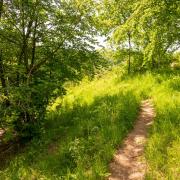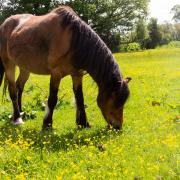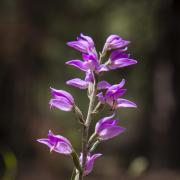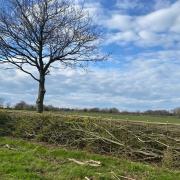Helen Harcombe finds out how the Waitrose WildCare scheme is enhancing wildlife on Cotswold dairy farms
Five years on ...How dairy farmers have helped wildlife thrive
Helen Harcombe finds out how the Waitrose WildCare scheme is enhancing wildlife on Cotswold dairy farms
As the largest area of outstanding natural beauty in England, part of the Cotswold’s appeal is the undulating land that is made up of a patchwork of fields. It’s under the custody of our region’s farmers, including three Oxfordshire dairy producers, who are doing their bit to enhance the wildlife that’s thriving in this precious landscape.
The Gasson family have farmed on the edge of the Cotswolds since the 1920s. They consider themselves lucky to farm in such a beautiful location whilst fully appreciating their stewardship and social responsibilities.
Ray Gasson’s 900 acres have become a haven for conserving and enhancing wildlife. Yet, its purpose is far removed from what most of us would think of as a nature reserve, with the dairy farm being home to 400 dairy cows supplying milk and cream to Waitrose branches.
“The business is structured in such a way to ensure continuation for future generations,” explains Ray. “That means having a strategy to be commercially successful and generate a sufficient level of profit to allow further investment in our farm, including its natural habitats.” It’s a business ethos that dovetails with the pioneering retail-led wildlife scheme ‘Waitrose WildCare’.
Established five years ago, the Waitrose WildCare Scheme encourages its dairy farmers to dedicate areas of land to enhance and preserve wildlife. The Gasson family’s proactive approach means they surpass the 10 per cent minimum requirement, today dedicating 24 per cent of their land to diverse wildlife habitats. This commitment is rewarded by an impressive wildlife list that to date includes; 84 species of birds, 22 species of butterflies, three species of orchids and 13 mammals, sighted on the farm.
“Through our involvement with Waitrose WildCare, and subsequently our relationship with Waitrose and Dairy Crest, we have an appreciation of the changing needs of the consumer and retail markets,” states Ray.
Sitting south of the Gassons, David Farrant and his son Andrew farm over 1,000 acres, milking 550 cows to supply milk and cream for the ‘essential Waitrose’ brand. David has a longstanding appreciation and commitment to his responsibilities for wildlife and the natural environment. Since 1989 he has managed a 25-acre wildflower meadow, applying no fertilisers or sprays, but instead deploying a grazing strategy to encourage wildflowers to seed and regenerate. Now home to three varieties of native orchid species, including the Early Marsh Orchid, the careful and continued management of this meadow is reaping significant rewards.
Elsewhere on the farm there are three and six metre-wide field margins, which have been planted with wild nectar and pollen mixes. It’s a practice that Tim Oliver, who heads up the wildlife scheme, describes as sustainable positive management. “Leaving field margins and awkward shaped field corners uncultivated provides food and shelter for several bird and mammal species – supporting brown hares, as well as voles to feed owls and kestrels,” says Tim. “They also provide an essential winter food source for seed eating birds.”
The task of identifying wildlife is the job of the independent auditors. They visit all 60 of the Waitrose dairy farms that make up the 100 million litre essential Waitrose milk pool. Unsurprisingly the Farrant’s wildlife list is equally as impressive as the Gasson’s with a total of 85 species of birds sighted on the farm along with 19 butterfly species, four varieties of orchids and numerous brown hares.
“One of my great delights is to see wildlife enjoying the farm,” comments David. “Making sure we keep wildlife habitats as they are and taking steps to improve and enhance where possible is particularly important to my son and I. Waitrose WildCare is a practical scheme that allows us to have a grazing based dairy farming system that goes hand in hand with wildlife conservation.”
Richard and Angela Gurney have an Oxfordshire dairy farm that yet again demonstrates outstanding commitment to the initiative. Dedicating a large part of their land to wildlife habitats they have invested considerable time and resources into the scheme.
Their 450-acre farm borders the Thames, making it ideal for the development of 30 acres of water meadows. These include shallow scrapings to encourage wintering waders such as lapwings, snipe and curlews. “These pastures used to be drained,” comments Angela Gurney. “But we want to transform them back into their natural state and in the future we hope to encourage traditional grasses for wading birds. We sighted at least four new broods of Lapwing chicks last spring and we hope to encourage more to breed this year.”
Angela adds; “the assessor visits and guidance provided by Waitrose WildCare help us to make positive changes and monitor our wildlife’s response to any actions.” Tim Oliver has witnessed how the audits provide a focus; “the auditors tailor their guidance to the individual farms and help with wildlife identification. We also encourage farmers to engage with other credible organisations that provide expert support to Waitrose WildCare, such as the Barn Owl Trust, Hardy Orchid Society and RSPB.”
Since 2006 Richard and Angela have also coppiced and re-laid over 1,200 metres of hedgerow and planted 300 metres of new ‘Saxon’ hedges. They also restrict hedgerow cutting to every other year. “Improving hedgerows and making small management changes allow hedgerows to flower and fruit. This in turn results in huge quantities of spring nectar for insects and autumn fruits for seed eating birds,” Tim comments.
Furthermore they have planted three and half acres of wild bird seed mix, the success of which was confirmed when an RSPB representative’s report revealed the presence of species of high conservation importance including; over 250 linnets, 100 reed buntings, 20 yellowhammers, as well as chaffinch, green and gold finches.
“Wild bird seed mix provides a practical way of ensuring the availability of winter food for farmland birds,” adds Tim, noting that since the scheme began there have been tangible increases in the numbers of farmland bird species recorded. For example the yellowhammer has now been sighted on all 60 farms despite numbers nationally being down; the same for reed bunting whose sightings have increased by 1,000 per cent and Linnet sightings, which are up by 1,700 per cent.
“Waitrose WildCare successfully demonstrates that 21st-century efficient dairy farming can incorporate wildlife friendly management practices with little disturbance to the everyday running of a professional dairy farm. The scheme is pragmatic and dynamic and it’s hoped that the next five years will be as successful, or if not more so, than the previous five,” concludes Tim.
For more information visit www.wildcare.co.uk



